Officially introducing my new speaker build. This one is "mostly" done, but unfortunately I won't be done with the second cabinet in time to make it to the Parts Express speaker competition. But I am far enough along that I have something to show.
My goal is to introduce an idea that is attainable for DIY, and I think it has the potential to change the way we do multiple subwoofers. It is not my idea, but I haven't seen anyone else in the DIY space attempt to do an active speaker like this. The idea is multiple active subwoofers incorporated into the main speakers. (It turns out to NOT be cardiod. I pursuied that angle, but did not end up with any promising results.)
My finding so far is that I can effectively control low frequency response in my room with DSP adjustments to the 4 subwoofers. I also get incredibly clean and detailed bass. I don't know if this configuration will work as well in every listening room or home theater, but I am optimistic. I would like to see other people explore the idea and see if their results are similar. I think that it is possible to use 8" or 10" drivers to achieve the same results, but in a smaller cabinet.
----
The story behind the build is that approx 1 year ago I was inspired to build a DIY version of the Genelec W371A. I was inspired because I saw it as a clever implementation of multiple subwoofers. Normal multiple subwoofer systems employ multiple subwoofers that are external to the main speakers, and placed around the room. But then Genelec made a speaker that to my eyes appeared to combine the subwoofers into the main speaker cabinets. I didn't know if it was really a multiple subwoofer system or something different, but I wanted to find out if it did work.
My intention was to build a W371A, but in a form factor that is more suitable for a living room. I chose to use 12" woofers for the front, and a 10" subwoofer in the rear. (Genelec used a 14" front woofer and a 12" rear woofer.) I built a couple prototypes to test the viability of the idea, and I quickly found that the concept of placing 2 subwoofers in the same cabinet was effective.
The next evolution happened when I was researching what studio monitor I wanted to use with my cabinets. I was hoping to find a pair of Genelec 8050s. But as I researched this project, I decided it would be more cost effective to make the speakers full range. I thought to myself that I might add a coaxial driver. Then a member suggested adding a 12" pro audio coaxial driver.
Now the origin of my design is slightly confusing with Genelec's recent announcement of the 8381A. My design has ended up being something like a smaller 8381A, which is kind of cool. (I don't presume that the performance of my design rivals that of Genelec's, but mine was slightly cheaper!)
----
The cabinet is 16" x 16" x 52", and made of moisture resistant MDF with a skin of carbon fiber cloth (carbon is primarily for aesthetics.) The drivers I'm using are B&C 12FHX76 12" Coaxial, Lab 12 12" woofer, and RSS265-HF-4 10" subwoofer. It is powered by an Emotiva XPA 8 channel amp (6 high power channels + 1 stereo channel). The signal processor is a Peavey VSX 48E. (Cooling fan delete is a critical mod to the Peavey processor!)
The subwoofer plays down to 20hz, and the front woofer has a steep high pass at 50hz. The mid woofer crosses to the horn at 1,200hz. I keep experimenting with the crossover points for the subwoofer, woofer, and mid, so I can't specify what works best.
The port design is something I'm proud of. Early on I decided I wanted the speaker to be 16"x 16", so the radius port design was the only solution that seemed viable. A lot of thought and experimentation went into the port, but I'm not sure what to say about it here. In terms of port noise and resonances, it seems to be as quiet as a Genelec "laminar spiral enclosure" subwoofer. I'm not sure what else to say. Ask if you have questions.
I'm powering the speaker through Speak-On connectors. It's a super clean way to power a 4 way speaker.
Remaining issues: The finish is OK from a distance, but needs a good polish. Maybe needs to be sprayed again to be "perfect". (Automotive 2k clear.) I still have to make the bezels to cover the edges of the drivers. Originally I was going to do aluminum, but now I'm leaning toward black. Black will give a subtle contrast to the carbon.
----
Below are some photos from the build.
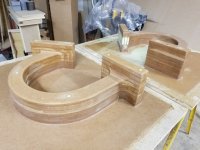
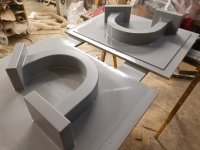
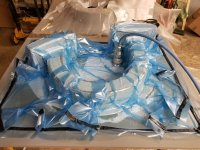
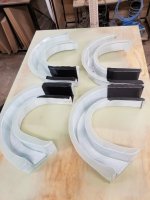
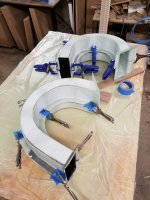
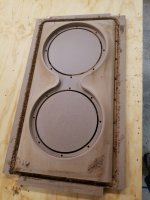
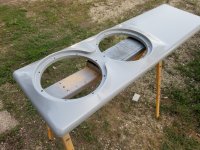
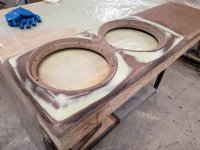
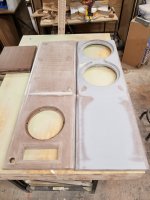
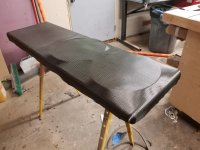
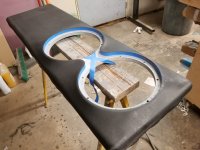
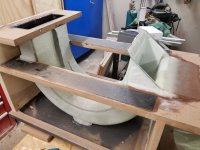
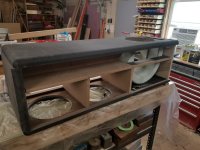
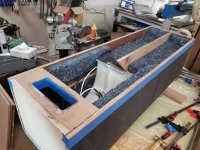
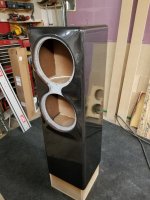
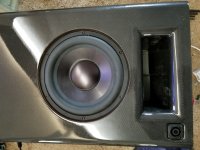
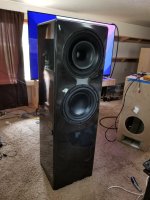
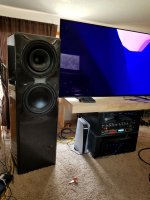
Last edited:
Configurations:
This speaker design readily lends itself to 2 different "normal" speaker configurations. It can be configured as a 2 way speaker + 4 subwoofers, or it can be configured as a 3 way speaker with 2 subwoofers.
Configured as a 2 way + 4 subs, the sub range can be well controlled, but I think a little is sacrificed in the low mids.
When configured as a 3 way with 2 subs, the sub range is not very well controlled.
This build isn't really about compromising, so I've been working on a way to try to get the best of both. I want to have a higher crossover on the front woofer, but I don't want to lose the ability to configure the multi sub array.
To make this happen, I need to send a signal to the front woofers that is summed below 100hz, and stereo above 100hz. I was stumped on how to do this for awhile. But then I remembered I have a line level mixer sitting in my rack, doing nothing.
I realized that to make this configuration work with my processor, I need a left, a right, and 2 summed signals going into the processor. To achieve this, I have splitter cable's on my DACs outputs. One pair of outputs goes directly into inputs 1 and 2, and the second pair goes to my line level mixer. I set both mixer input channels to mono, which creates a summed singal on both stereo outputs of the mixer...and I run those now summed outputs to inputs 3 and 4 on my processor. Now i have 2 stereo inputs and 2 summed inputs.
On the processor I then set a high pass filter at 100hz on the first 2 inputs, and a low pass at 100hz on the second 2 inputs. This allows me to seamlessly combine the summed and stereo signals and send it to a the front woofers.
But there's another trick to make the multiple sub configuration work. I'm relying heavily on delays to make the multiple sub system work, but if I put my delay on the front woofer, I'm delaying the entire signal, including the 100-300hz portion of the stereo signal! I can't have that!
This is why I need 2 summed inputs. My processor has delays on the input and outputs, and I am now using the input delays to get the required delays for the front woofers. Once those are set, I subtract the input delays from the desired rear sub delays to get the 4 different delay settings I need to make my multiple sub system work.
It's a little complicated, but it gives me the higher crossover without sacrificing the multi-sub aspect of the build.
This speaker design readily lends itself to 2 different "normal" speaker configurations. It can be configured as a 2 way speaker + 4 subwoofers, or it can be configured as a 3 way speaker with 2 subwoofers.
Configured as a 2 way + 4 subs, the sub range can be well controlled, but I think a little is sacrificed in the low mids.
When configured as a 3 way with 2 subs, the sub range is not very well controlled.
This build isn't really about compromising, so I've been working on a way to try to get the best of both. I want to have a higher crossover on the front woofer, but I don't want to lose the ability to configure the multi sub array.
To make this happen, I need to send a signal to the front woofers that is summed below 100hz, and stereo above 100hz. I was stumped on how to do this for awhile. But then I remembered I have a line level mixer sitting in my rack, doing nothing.
I realized that to make this configuration work with my processor, I need a left, a right, and 2 summed signals going into the processor. To achieve this, I have splitter cable's on my DACs outputs. One pair of outputs goes directly into inputs 1 and 2, and the second pair goes to my line level mixer. I set both mixer input channels to mono, which creates a summed singal on both stereo outputs of the mixer...and I run those now summed outputs to inputs 3 and 4 on my processor. Now i have 2 stereo inputs and 2 summed inputs.
On the processor I then set a high pass filter at 100hz on the first 2 inputs, and a low pass at 100hz on the second 2 inputs. This allows me to seamlessly combine the summed and stereo signals and send it to a the front woofers.
But there's another trick to make the multiple sub configuration work. I'm relying heavily on delays to make the multiple sub system work, but if I put my delay on the front woofer, I'm delaying the entire signal, including the 100-300hz portion of the stereo signal! I can't have that!
This is why I need 2 summed inputs. My processor has delays on the input and outputs, and I am now using the input delays to get the required delays for the front woofers. Once those are set, I subtract the input delays from the desired rear sub delays to get the 4 different delay settings I need to make my multiple sub system work.
It's a little complicated, but it gives me the higher crossover without sacrificing the multi-sub aspect of the build.
Last edited:
Nice design! I'd been thinking about something similar. Can I ask:
Thanks!
- Are you using Multi Sub Optimizer to calculate the processing for the sub drivers?
- How did you choose the physical distance between the sub drivers?
- Is there a reason for 1 sub in each side being vented and sealed?
Thanks!
Good One! 
Looking forward to more technical details, descriptions and measurements of this system. I was curious about the W371A, but it seemed to be solution in search of a problem.
The 8381A, on the other hand, is a terribly ugly speaker 4 of those eyeball midranges. Why did they not just use a larger midrange coaxial? And terribly expensive too.
Your design looks easier on the eye. Well, as much as speakers that are 16" wide can be.
Looking forward to more technical details, descriptions and measurements of this system. I was curious about the W371A, but it seemed to be solution in search of a problem.
The 8381A, on the other hand, is a terribly ugly speaker 4 of those eyeball midranges. Why did they not just use a larger midrange coaxial? And terribly expensive too.
Your design looks easier on the eye. Well, as much as speakers that are 16" wide can be.
I am not using MSO. I have experimented with it, but it did now work very well for my specific driver configuration. In the instructions for MSO it says that 2 subs placed near each other are treated as a single sub, so it just isn't designed for the purpose.Nice design! I'd been thinking about something similar. Can I ask:
- Are you using Multi Sub Optimizer to calculate the processing for the sub drivers?
- How did you choose the physical distance between the sub drivers?
- Is there a reason for 1 sub in each side being vented and sealed?
Thanks!
I optimize the subs using REW's Time Alignment tool. The tool estimates frequency response from changes in phase and delays. So I measure the 4 subs individually, with a timing reference, and then time align them together one at a time. Like I do 2, take a combined measurement of the 2, and then align the 3rd to the combined measurement. (I'm not aligning phase at a frequency, but just adjusting until I have a flat response.) Using delays only, I can achieve +-4dB from 20-100hz. This can be improved at a single listening position with EQ, but I haven't been doing that.
The driver configuration is based on the W371A, which combines a ported sub and a sealed sub. The sealed sub doesn't have the extension of the ported sub, so they compliment each other. But the sealed sub is very detailed and can extend above 100hz.
I chose a 10" and a 12", because Genelec used 2 different sizes. But that was a mistake. I should have used 12" for both, and am currently working on a retrofit.
I estimate the front woofer needs to extend down to ~50hz before rolling off, but the 14" mid woofer they chose would roll off between 80-100hz. So they need DSP to boost the low frequencies, which reduces dymanic range...so the bigger woofer is needed.
I think my theory is confirmed by the fact that on the 8381A, the front facing woofer is now a subwoofer driver, not a mid woofer. Changing to the sub driver created the problem that it can't cross directly to the coaxial, so they added the 4- 5" mid drivers to bridge the gap.
I'd love to see you try it! I'm curious how it would work to base it off of 8" or 10" drivers...maybe dual 10's?
The W371A is multiple subwoofers in stereo cabinets. It's genius!Good One!
Looking forward to more technical details, descriptions and measurements of this system. I was curious about the W371A, but it seemed to be solution in search of a problem.
The 8381A, on the other hand, is a terribly ugly speaker 4 of those eyeball midranges. Why did they not just use a larger midrange coaxial? And terribly expensive too.
Your design looks easier on the eye. Well, as much as speakers that are 16" wide can be.
I see all the stress people put themselves through trying to find the perfect location for their subwoofers, and the struggle they have getting their wife to accept having 4 giant subwoofers placed seemingly randomly around the room. I know, people are just starting to understand how that works, but this design can give the same bass response with only a stereo pair. I think the advantage is obvious!
(these could be part of a multi-channel system too....someday I'll make a center and surrounds with 12" coaxials to match.)
Nice work Fred……but you‘ve ignored an internal conflict
Instead of having four subs placed around the room ( these no longer need to be large…..DSP, amp power and high excursion drivers have seen to that.)….you have these two hulking towers of power?…….not sure but I’m betting on this doesn’t go over well with the female paternal family unit either.
I recently put together a microcosm system for a party type couple……lots of people grooving at 100db peaks fueled by whatever substance is available….get the idea? Lol. So compact mains…..B&C 8pe21s crossed to a 1” faital CD and a STH100 lens……9” wide boxes. Crossed to four subs corner loaded with Dayton RSS390 drivers sealed with DSP and corrected for an in room response f3 around 22hz……..minimal impact to the living space and the subs are small at 18x18x20 with the two fwd firing and 18x20x20 for the downfiring boxes.
Instead of having four subs placed around the room ( these no longer need to be large…..DSP, amp power and high excursion drivers have seen to that.)….you have these two hulking towers of power?…….not sure but I’m betting on this doesn’t go over well with the female paternal family unit either.
I recently put together a microcosm system for a party type couple……lots of people grooving at 100db peaks fueled by whatever substance is available….get the idea? Lol. So compact mains…..B&C 8pe21s crossed to a 1” faital CD and a STH100 lens……9” wide boxes. Crossed to four subs corner loaded with Dayton RSS390 drivers sealed with DSP and corrected for an in room response f3 around 22hz……..minimal impact to the living space and the subs are small at 18x18x20 with the two fwd firing and 18x20x20 for the downfiring boxes.
Yeah - the concept is great!The W371A is multiple subwoofers in stereo cabinets. It's genius!
I'm just fooling and measuring around with something similar in a smaller cabinet to find out if the position of the drivers up and down is benefit enough to let the "impuls compensation" benefit go. My first trials where in my highly dampened listening/measurement room - influences where only >100Hz there. tbc...
Nice work Fred……but you‘ve ignored an internal conflict
Instead of having four subs placed around the room ( these no longer need to be large…..DSP, amp power and high excursion drivers have seen to that.)….you have these two hulking towers of power?…….not sure but I’m betting on this doesn’t go over well with the female paternal family unit either.
I recently put together a microcosm system for a party type couple……lots of people grooving at 100db peaks fueled by whatever substance is available….get the idea? Lol. So compact mains…..B&C 8pe21s crossed to a 1” faital CD and a STH100 lens……9” wide boxes. Crossed to four subs corner loaded with Dayton RSS390 drivers sealed with DSP and corrected for an in room response f3 around 22hz……..minimal impact to the living space and the subs are small at 18x18x20 with the two fwd firing and 18x20x20 for the downfiring boxes.
Pease don't think that it only works with big drivers!
I find your comments contradictory. You said that subwoofers don't need to be large, and then you gave an anecdote of four 4 cubic foot subwoofers. Do you consider those to be large or small? In your anecdote, you have 16 cubic feet of subwoofer, plus another 2-4 cubic feet for the mains? That's something like 20 cubic feet of speaker cabinets!
By comparison, a pair of my oversized speakers takes up "only" 14 cubic feet, and with them I am able to achieve 115dB @ 20hz. (The front facing drivers can all exceed 115dB, but the rear sub is excursion limited at ~115dB...so you might notice some bass compression when you exceed 115dB...you've been warned!)
I really hope someone tries to apply this principle with something like 8" drivers.
External dimensions of the enclosures at 18x18x18……if that’s too large for you….particularly placed in wasted space corners?………and this is the large end of the scale……tone down the volume and in a smaller room, 4 8-10” subs can get it done. Remember the build, stupid loud and pant slapping edm low end for high as fu€k Gen Xers…this space could host a hundred guests.
I don't know what you are saying. I feel like it's inappropriate to characterize your customers this way.External dimensions of the enclosures at 18x18x18……if that’s too large for you….particularly placed in wasted space corners?………and this is the large end of the scale……tone down the volume and in a smaller room, 4 8-10” subs can get it done. Remember the build, stupid loud and pant slapping edm low end for high as fu€k Gen Xers…this space could host a hundred guests.
I posted this project because it is an attempt at science. I shared what I did and how I did it. I want someone else to try the same driver configuration to see if they can also achieve flat low frequency response.
Its not science yet - not without before and after room measurementsI posted this project because it is an attempt at science. I shared what I did and how I did it. I want someone else to try the same driver configuration to see if they can also achieve flat low frequency response.
also interested in how the top end with that 12" coax came out
This was about the physical construction of the speaker. I've posted measurements elsehwere, but since you asked. I have posted threads about measurements and optimization techniques and asked members for input. This one was about the physical build, but a lot of work was done before I got to this stage.
This is the coax horn and mid woofer, as configured currently. Crossed at 1200hz. Yes, there is some DSP applied to fix the response. And it is only rated up to 18khz. I know I don't even hear 18khz, so it's a mute point, literally!

Combined low frequency response I measured most recently. This is still experimental.

This is the coax horn and mid woofer, as configured currently. Crossed at 1200hz. Yes, there is some DSP applied to fix the response. And it is only rated up to 18khz. I know I don't even hear 18khz, so it's a mute point, literally!
Combined low frequency response I measured most recently. This is still experimental.
Its not science yet - not without before and after room measurements
also interested in how the top end with that 12" coax came out
How about some raw data? Attached below. I've been "fact checking" myself recently, and here I did comparisons of different configurations.
I included raw driver data used for calculating the delays, plus 3 sets of comparison measurements.
First comparison is with zero optimization; all drivers in phase. Second is with the left sub (rear facing) inverted as the only change. Third is the result of the delays I added, and none of the channels inverted. None of these use EQ to adjust frequency response.
I did the "optimization" exclusively for seating position 1. And then I measured it in 2 more spots to check uniformity.
The surprising thing for me is that the effect of inverting one subwoofer gave a similar result to the delay scheme! I don't know if this will always make a big improvement, but it is interesting.
These measurements explains why I was struggling to hear a tangible difference between the "with delays" and the "without delays". There really isn't that much difference.
Attachments
Its clear you got very good/flat response so I'm tempted to try something similar - adding delayed/inverted subs next to full range mains. REW room sim gives encouraging results for my room - definitely better than simulated full range mains w/o nearby subs - but still just a simulation.
If this works, its highly preferable to scattering subs around the room. For me, that would never pass WAF. so Kudos
If this works, its highly preferable to scattering subs around the room. For me, that would never pass WAF. so Kudos
- Home
- Design & Build
- Construction Tips
- Build Thread of DIY Genelec 8381A/ W371A (Evolution of Integrating Multiple Subwoofers)